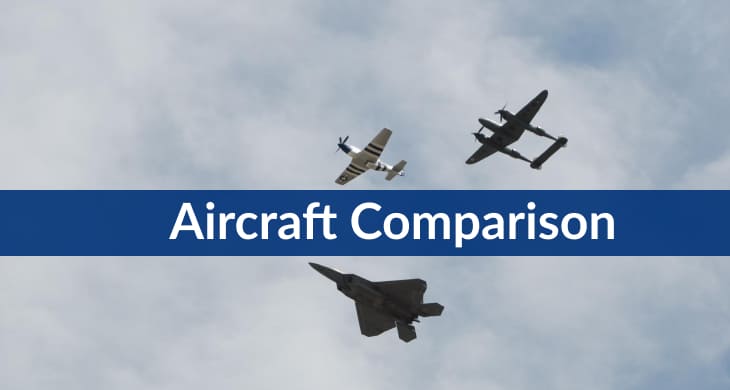The Hellcat was a carrier-based fighter used by the United States Navy, while the Bearcat was land-based and used by the United States Marine Corps. Both aircraft were designed for air-to-air combat and had similar specifications. Here’s a closer look at how F6F Hellcat vs F8F Bearcat compares.
| Aircraft: | Grumman F6F Hellcat | Grumman F8F Bearcat |
|---|---|---|
| Photo: |
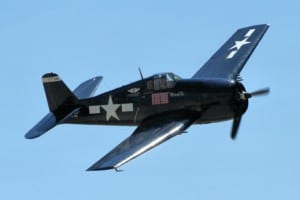 |
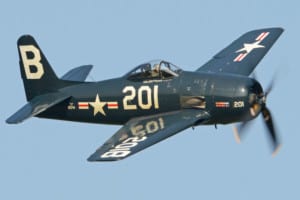 |
| Country: | United States | United States |
| Manufactured: | from: 1942 to: 1945 | from: 1943 to: 1949 |
| ICAO: | F6F | F8F |
| Price: | $0.035 million | $ million |
| Avionics: | AN/APS-4 Radar | AN/ARC-1, AN/ARR-2A, R-23/ARC-5 |
| Engine: | 1x Pratt & Whitney R-2800 Double Wasp | 1x Pratt & Whitney R-2800-30W Double Wasp |
| Engine Type: | Piston | Piston |
| Power: | 2,000 horsepower | 2,250 horsepower |
| Max Cruise Speed: |
340 knots 630 Km/h |
395 knots 732 Km/h |
| Approach Speed (Vref): | 75 knots | 74 knots |
| Travel Range: |
950 Nautical Miles
1,759 Kilometers |
960 Nautical Miles
1,778 Kilometers |
| Fuel Economy: | - | - |
| Service Ceiling: | 37,000 feet | 40,800 feet |
| Rate of Climb: |
3650 feet / minute 18.54metre / second |
4465 feet / minute 22.68metre / second |
| Take Off Distance: |
475 metre 1,558.38 feet |
185 metre 606.95 feet |
| Landing Distance: |
570 metre 1,870.06 feet |
250 metre 820.20 feet |
| Max Take Off Weight: |
6,992 Kg 15,415 lbs |
6,105 Kg 13,459 lbs |
| Max Landing Weight: |
5,714 Kg 12,597 lbs |
5,941 Kg 13,098 lbs |
| Max Payload: |
1,800 Kg 3,968 lbs |
1,000 Kg 2,205 lbs |
| Fuel Tank Capacity: |
250 gallon 946 litre |
535 gallon 2,025 litre |
| Baggage Volume: | - | - |
| Seats - Economy: | 1 seats | 1 seats |
| Seats - Business Class: | - | - |
| Seats - First Class: | - | - |
| Cabin Height: | - | - |
| Cabin Width: | - | - |
| Cabin Length: | - | - |
| Exterior Length: |
10.24 metre 33.60 feet |
8.43 metre 27.66 feet |
| Tail Height: | 3.99 metre - 13.09 feet | 4.16 metre - 13.65 feet |
| Fuselage Diameter: |
1.5 metre 4.92 feet |
1.35 metre 4.43 feet |
| Wing Span / Rotor Diameter: |
13.06 metre 42.85 feet |
10.82 metre 35.50 feet |
| Wing Tips: | No Winglets | No Winglets |
| More Info: | Grumman F6F Hellcat | Grumman F8F Bearcat |
|
Data presented is for entertainment purposes and should not be used operationally.
|
Other Grumman F6F Hellcat comparisons:
Other Grumman F8F Bearcat comparisons:
About the F6F Hellcat
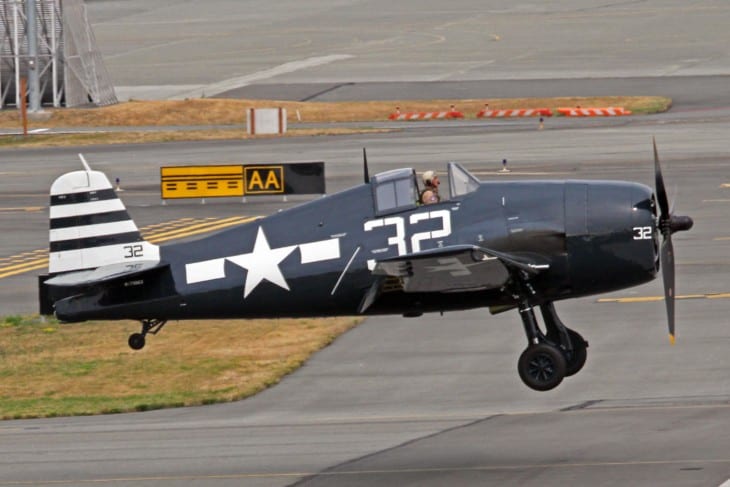
The F6F Hellcat was a naval fighter aircraft used by the U.S. Navy during World War II. Its design was based on the earlier F4F Wildcat, and the two aircraft were very similar in appearance. After the war, the Hellcat continued to serve with the U.S. Navy and Marine Corps until it was replaced by newer jet-powered aircraft in the 1950s.
Why was it developed and built
The F6F Hellcat was designed in response to the Japanese Zero, which had outperformed existing American fighters during the early days of WWII. While the Zero was maneuverable and had a longer range, it was lightly built and not as rugged as American fighters.
What purpose does it serve?
The Hellcat was designed to be a heavier and more powerful plane that could take on Zero on equal footing. It first saw action in 1943 and quickly proved a formidable adversary. The U.S. Marine Corps also used the aircraft and saw action in several campaigns in the Pacific Theater.
About the F8F Bearcat
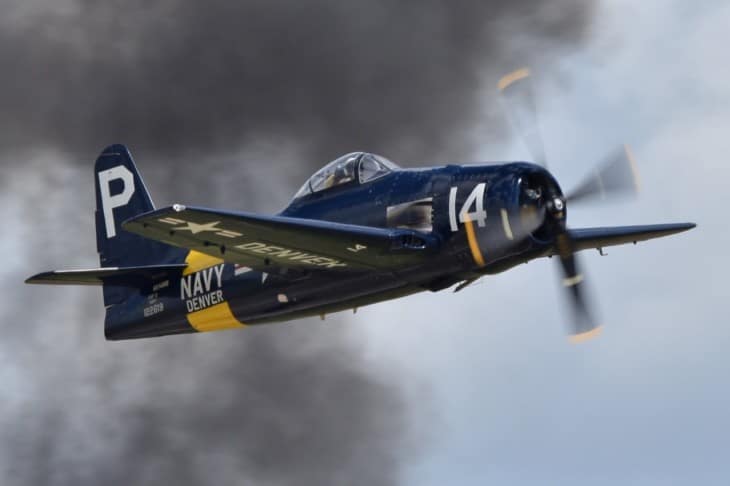
The F8F Bearcat was a single-engine fighter aircraft introduced late in World War II. It was designed to be small and light, with a powerful engine and good maneuverability. And it was one of the fastest aircraft of its day and could outclimb and out-turn most opponents.
Why was it developed and built?
The F8F Bearcat, on the other hand, was designed as an improved version of the earlier F7F Tigercat fighter. Like the Hellcat, it was intended to be a rugged and powerful plane that could take on enemy fighters on equal terms.
What purpose does it serve?
It went on to serve in the post-war U.S. Navy and other air forces, seeing action in the Korean War, Indochina War, and other conflicts. The Bearcat retired from front-line service in the early 1950s but continued to serve in second-line roles until the late 1960s.
How are the F6F Hellcat and F8F Bearcat different?
The F6F Hellcat and the F8F Bearcat were World War II’s most celebrated carrier-based aircraft. Though both aircraft were highly influential in combat, they had very different strengths and weaknesses.
Powerplants
The F6F Hellcat was powered by a Pratt & Whitney R-2800 Double Wasp engine that produced 2,000 hp. The F8F Bearcat, on the other hand, was equipped with a much more powerful Pratt & Whitney R-2800-34W engine that delivered 2,250 hp. This gave the Bearcat a significant advantage in terms of power and performance.
Speed and Range
The Hellcat had a top speed of 391 mph and a range of 945 miles. The Bearcat could reach up to 445 mph speeds and had a range of 1,105 miles. Again, the Bearcat had superior performance in this area.
Combat Record
The Hellcat and the Bearcat were highly influential in combat against Japanese aircraft. The Hellcat shot down 5,163 enemy planes during WWII, while the Bearcat destroying record isn’t much updated. So, it’s important to note that the Hellcat saw far more action than the Bearcat—the Bearcat did not see combat until 1945, near the war’s end.
How are the F6F Hellcat and F8F Bearcat similar?
F6F Hellcat and F8F Bearcat are two fighter aircraft used by the United States during World War II.
- They are both single-engine, propeller-driven planes that were designed for carrier-based operations.
- Both planes were armed with six .50 caliber machine guns and could carry rockets and bombs.
- The Hellcat was produced in more significant numbers than the Bearcat; while Bearcat entered service too late to see combat in World War II, it saw action during the Korean War.
- In terms of overall performance, both planes could take on enemy fighters and hold their own in combat.
What’s better about the F6F Hellcat?
F6F Hellcats were American carrier-based fighters during World War II. The aircraft was designed to be a more robust and maneuverable successor to the earlier F4F Wildcat.
The Hellcat proved an effective fighter, shooting down thousands of enemy aircraft during the war. Its success was partly due to its superior speed, armament, and range.
Moreover, the Hellcat could reach speeds of up to 391 mph, making it one of the fastest fighters of its time. It was armed with six 0.50-caliber machine guns and could carry up to 1,000 pounds of bombs. The Hellcat’s superior performance made it one of the most successful fighters of World War II.
What’s better about the F8F Bearcat?
The Bearcat first flew in August 1944 and quickly proved one of the fastest and most maneuverable aircraft. It could achieve a top speed of nearly 445 miles per hour, and its sleek design made it exceptionally agile.
The Bearcat was also armed with four 20 mm cannons, making it a formidable opponent in combat. In addition, the Bearcat had a relatively short wingspan, which made it easier to take off and land on smaller carriers.
As a result, the Bearcat became an essential part of the U.S. Navy’s air power during the latter stages of World War II. After the war, the Bearcat served with distinction in several conflicts, including the Korean War and the Vietnam War.
Today, the Bearcat is revered by aviation enthusiasts as one of the finest fighter aircraft ever built.
Conclusion
So when comparing F6F Hellcat vs F8F Bearcat, which is better? It depends on what you’re looking for. The F6F Hellcat and the F8F Bearcat were outstanding carrier-based aircraft that played a crucial role in the Allied victory during World War II. Though they shared some similarities, they also had some very distinct differences.
If you want an aircraft that was used in greater numbers and saw more action, then the Hellcat is the better choice. However, the Bearcat is better if you’re looking for a faster and more maneuverable aircraft.
